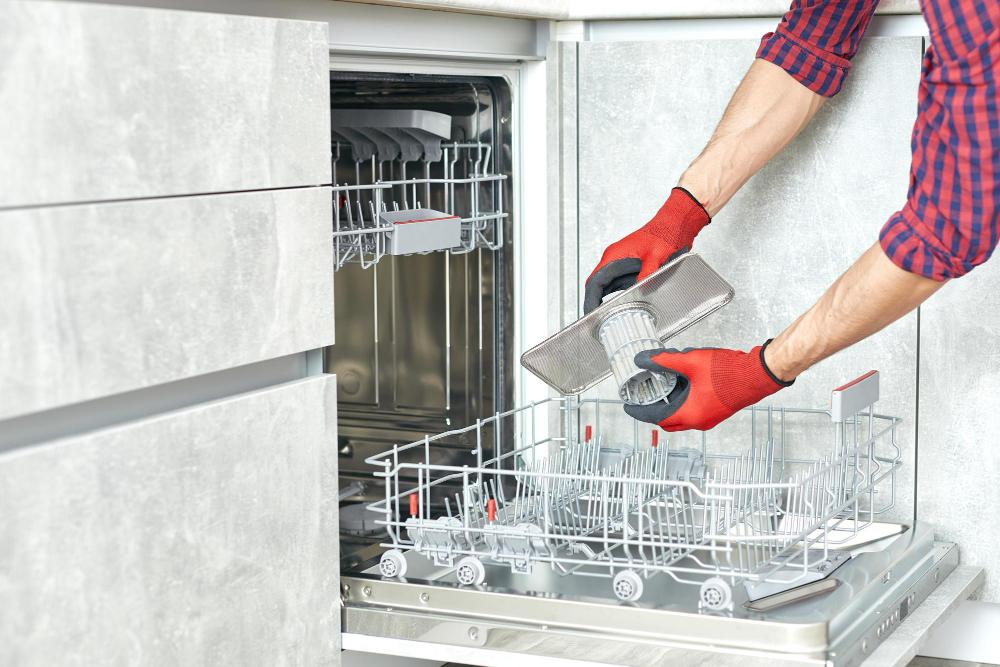A dishwasher is an invaluable appliance in any kitchen, effortlessly handling dirty dishes and saving precious time. However, over time, the dishwasher itself can accumulate buildup and soap scum, impacting its performance and the cleanliness of our dishes. Regular cleaning and maintenance are essential to keep your dishwasher running smoothly and ensure sparkling clean dishes. This article will guide you through a comprehensive and easy ways to clean your dishwasher and remove stubborn buildup and soap scum.
Steps to remove buildup and soap scum from Dishwasher

Step 1: Gather Your Supplies
Before embarking on the cleaning process, gathering all the necessary supplies is essential. Here's what you'll need:
- Rubber gloves: These will protect your hands from any harsh chemicals.
- Vinegar: A natural cleaning agent that effectively cuts through grease and removes soap scum.
- Baking soda: It acts as a gentle abrasive and helps eliminate odors.
- Dish soap: A mild dish soap will be helpful for specific cleaning tasks.
- Soft-bristle brush or toothbrush: Ideal for scrubbing hard-to-reach areas and removing stubborn residue.
- Microfiber cloth or sponge: For wiping down surfaces and ensuring a thorough clean.
Step 2: Clear Out the Dishwasher
Start by removing all dishes, racks, and utensil holders from the dishwasher. This will allow you better access to all areas of the appliance during the cleaning process. Set the dishes aside, and we'll get back to them later.
Step 3: Remove and Clean the Filter
Most dishwashers have a filter located at the bottom of the tub. This filter traps food particles and prevents them from clogging the drain. Cleaning the filter is crucial for maintaining the dishwasher's performance. Here's how to do it:
- Twist or lift the filter cover to remove it. Different dishwashers may have different mechanisms, so consult your dishwasher's manual if needed.
- Rinse the filter under warm water to remove any loose debris. This will help clear out the larger particles and make cleaning more manageable.
- Take a soft brush or toothbrush and gently scrub the filter to remove any stubborn residue. Pay attention to the crevices and corners of the filter.
- Once thoroughly cleaned the filter, place it back in its original position and secure the cover. Ensure it is fitted properly to prevent any leaks during the next cycle.

Step 4: Wipe Down the Interior
Soap scum and buildup can accumulate on the walls and door of your dishwasher, diminishing its efficiency and leaving residues on your dishes. To effectively remove this buildup, follow these steps:
- Dampen a microfiber cloth or sponge with vinegar. Vinegar is a natural and non-toxic cleaner that is effective against soap scum.
- Wipe down the interior surfaces of the dishwasher, paying extra attention to areas with visible residue. These may include the walls, door, and any other surfaces that come into contact with water during the cleaning cycles.
- For areas with stubborn buildup, you can create a paste with baking soda and water. Apply the paste to the affected areas and let it sit for a few minutes to allow the baking soda to work its magic. Then, gently scrub the surface in circular motions using a soft brush or toothbrush to loosen the residue.
- Rinse the interior with water or wipe it down with a clean, damp cloth to remove any remaining vinegar or baking soda residue. This step will leave your dishwasher fresh and clean.
Step 5: Clean the Spray Arms
The spray arms in your dishwasher are responsible for distributing water and detergent to clean your dishes effectively. Over time, these spray arms can become clogged with debris, affecting their performance and leading to poor cleaning results. To clean the spray arms, follow these steps:
- Remove the spray arms from the dishwasher. Depending on your dishwasher model, you may need to unscrew them or release a locking mechanism. Refer to your dishwasher's manual for specific instructions.
- Rinse the spray arms under running water to remove any visible debris. This will help clear out larger particles that may obstruct the spray nozzles.
- Inspect the spray arm nozzles for any clogs. If you notice any blockages, use a toothpick or a small wire to clear the debris from the nozzles gently. Be careful not to damage the spray arm or the nozzles while doing this.
- Once you've cleaned the spray arms thoroughly, reattach them securely back into their original positions. Ensure they are adequately tightened to ensure optimal performance during the next dishwasher cycle.
Step 6: Run a Cleaning Cycle
After completing the above steps, running a cleaning cycle is a good idea to remove any remaining residue and freshen up your dishwasher. Here's how:
- Place a dishwasher-safe cup filled with vinegar on the top rack of your dishwasher. Vinegar is an excellent natural cleaner that helps eliminate odors and dissolves any remaining buildup.
- Run a hot water cycle on your dishwasher using the vinegar-filled cup. The hot water and vinegar will help break down and remove any lingering residue or soap scum.
- Once the cycle is complete, sprinkle a small amount of baking soda on the bottom of the dishwasher. Baking soda is known for its odor-absorbing properties and will leave your dishwasher smelling fresh.
- Run another short hot water cycle to allow the baking soda to work magic. This final step will help eliminate any remaining odors and leave your dishwasher sparkling clean.
Step 7: Maintain Regular Cleaning
To prevent future buildup and soap scum, incorporate these practices into your regular dishwasher maintenance routine:
- Scrape off excess food from dishes before loading them into the dishwasher. This will help prevent food particles from clogging the filter or spray arms.
- Run your dishwasher regularly. A dishwasher that is used regularly is less likely to accumulate stagnant water and develop unpleasant odors.
- Periodically check and clean the filter. Make it a habit to inspect the filter and clean it at least once a month or as your dishwasher's manual recommends. This will ensure optimal performance and prevent clogs.
- Consider using dishwasher cleaner tablets or packets. These products are specifically designed to remove stubborn residue and maintain the cleanliness of your dishwasher. Follow the manufacturer's instructions for usage and frequency.

Conclusion
Following these comprehensive steps, you can effectively clean your dishwasher and remove stubborn buildup and soap scum. Regular maintenance and cleaning will keep your dishwasher running efficiently and ensure your dishes come out spotless every time. Consider your dishwasher's manual for specific cleaning instructions or any precautions you must take. With a clean and well-maintained dishwasher, you can enjoy the convenience of sparkling clean dishes with every wash.
FAQs (Frequently Asked Questions)
How often should I clean my dishwasher?
It is recommended to clean your dishwasher at least once a month to prevent the buildup of residue and soap scum. However, if you notice any signs of decreased performance or odors, it's a good idea to clean it more frequently. Regular cleaning and maintenance will help ensure optimal dishwasher performance and cleaner dishes.
Can I use bleach to clean my dishwasher?
While bleach is a powerful disinfectant, it is not recommended for regular dishwasher cleaning. Bleach can be too harsh for the internal components of the dishwasher and may cause damage over time. Instead, opt for natural cleaners like vinegar and baking soda, which effectively remove buildup and soap scum without causing harm to your dishwasher.
Why is it important to clean the filter in my dishwasher?
The filter in your dishwasher plays a vital role in trapping food particles and preventing them from clogging the drain or getting redeposited on your dishes. Cleaning the filter regularly ensures it can effectively perform its function, leading to cleaner dishes and preventing drainage issues. Neglecting to clean the filter can result in reduced dishwasher performance and may lead to unpleasant odors or clogs.


No comments yet